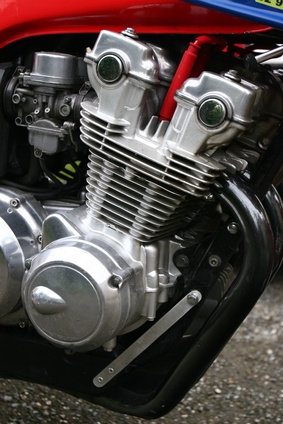
When your bike is idling unevenly, surging at cruising speeds or even failing to start, the culprit is often somewhere in the fuel system. For bikes with multiple cylinders and individual carburetors, the likely cause is a carburetor that is out of sync with its brethren. Each unit must perform in lockstep with the others. Time, temperature and wear and tear can throw off the delicate balance. When that happens, it's time to get dirty and balance the load.
Put your bike on the center kick stand either outdoors or in a well-ventilated garage with the door open. You'll need to run the engine, so don't make the mistake of doing that in a closed garage.
Set up a powerful fan next to the bike to help keep the engine cool. The cooling fins on your bike's engine rely on the apparent wind created when the bike is in motion to keep the block from overheating. Since you'll be standing still, you will need to keep plenty of airflow on the engine.
Remove any body work or other obstructions so you have clean access to the back of the carburetors.
Find the ports for each carburetor on the intake track. The port is a metal tube extending upward from the intake covered either by a rubber nipple or a screw. Each carburetor has its own port. Remove the plug (be it metal screw or rubber nipple).
Attach the manometer lines to each of the carburetor ports. With the manometer face up, attach the leftmost line to the port on the leftmost carburetor and work from left to right. Keep the lines free of any kinks or obstructions that could interrupt the flow.
Start the bike using as little throttle as possible, and let it idle until the engine is warm. Don't forget to turn on the fan to keep the engine from getting too warm.
Locate the vacuum adjustment screws along the top of the row of carburetors on the shared throttle arm. If you need help figuring out what the arm looks like, twist the throttle hand grip slightly and you will see the arm move back and forth. A standard, four-cylinder bike will have three adjustment screws along the throttle arm.
Read the manometer for carburetors one and two (beginning from the left). Turn the leftmost adjustment screw to bring the vacuum readings for those two carburetors equal to each other. Turn the screw clockwise slightly and back again to get a sense of the effect on your readings. Do the same for carbs three and four using the rightmost adjustment screw. When your settings are balanced for each pair, use the adjustment screw in the center to bring the two pairs into balance with each other.
Adjust the idle (fuel mixture) screw to set the appropriate idle speed. You can call your local shop to ask about the proper setting or check the service manual for your bike if you have it. Make sure you are using the warm idle recommendation as, at this point, your bike is at full running temperature.
Tweak your vacuum settings if the idle adjustment threw them off slightly. Keep working back and forth from the carburetor adjustment screws to the idle adjustment screws until you have an equal vacuum for the four carbs and your idle is smooth and running at the proper speed.
Turn off the engine and remove the manometer lines. Do not forget to replace the vacuum plugs in the carburetor ports to seal the air intake and preserve the balance of your newly tuned carburetors.